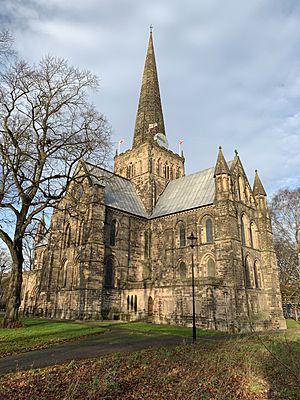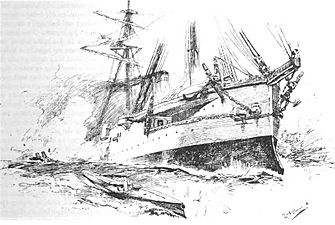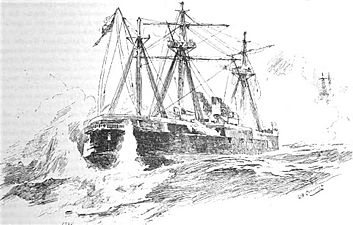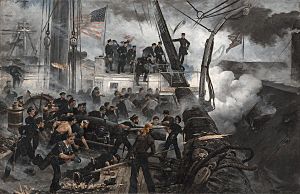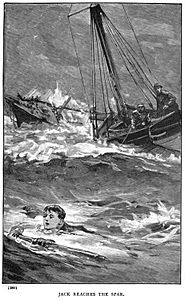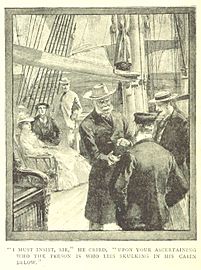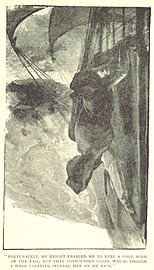William Heysham Overend facts for kids
Quick facts for kids
William Heysham Overend
|
|
|---|---|

William Heysham Overend with a sketchpad
|
|
| Born | 5 October 1851 Coatham Mundeville, Darlington, Durham
|
| Died | 18 March 1898 (aged 46) London, England
|
| Nationality | British |
| Other names | WHO |
| Occupation | Marine artist and illustrator |
| Years active | 1872 – 1898 |
| Known for | Marine paintings and illustrations |
|
Notable work
|
An August Morning with Farragut: The Battle of Mobile Bay |
William Heysham Overend (October 5, 1851 – March 18, 1898) was a talented British artist. He was known for his paintings of ships and the sea, and for illustrating many books. He was also a member of the Royal Institute of Oil Painters.
Contents
William Overend's Early Life
William Heysham Overend was born on October 5, 1851. He was likely born in Coatham Mundeville, a small village near Darlington, in County Durham, England. Some people thought he was born in a different Coatham, but records show his birth was registered in Darlington. He was also baptized in St Cuthbert's Church, Darlington, which is close to Coatham Mundeville.
His parents were James Overend, who worked with flax, and Martha Hodgson. His mother came from a wealthy family. In the 1850s, his family lived in Darlington. By 1861, they had moved to Hackney, London, and his father worked for the railway.
William went to Charterhouse School for one year. Then he attended Bruce Castle School until 1867. Even at 14, he was already a very good artist. One person said a sketch he drew at that age was good enough for a student at the Royal Academy.
After school, William spent three years learning art in the studio of Davis Cooper. He continued to teach himself art after that. By 1871, he was living in London and working as an artist.
William Overend's Art and Illustrations
It was hard for William Overend to make a living as a painter at first. He first showed his work at the Royal Academy of Arts in 1872. He continued to show his art in many places throughout his life. These included the Royal Academy, the Society of British Artists, and galleries in Liverpool and Glasgow.
Overend also became a well-known illustrator. He started working for the Illustrated London News in 1875. For about ten years, he was one of their most important illustrators. He also drew for many other magazines, including The English Illustrated Magazine, Good Words, and popular children's magazines like The Boy's Own Paper and Chums.
William Overend was very careful and detailed in his work. He even kept a collection of old uniforms and weapons to use as models for his drawings. At a Naval Exhibition in 1891, he loaned some of his collection. This included naval swords, a model ship, and old navy coats and hats.
He was not just a painter and illustrator, but also an engraver. He likely carved the woodcuts for some of his illustrations himself.
In 1886, Overend became a member of the Royal Institute of Painters in Oils. In 1897, he was elected to the Council of the Navy Records Society. This shows that both artists and naval historians respected his work.
How William Overend Illustrated Ships
It's interesting that Overend was born far from the sea and had no family in the navy. Yet, he knew a lot about ships, both old and new. His knowledge of warships was amazing, even to sailors. He drew many illustrations of ships for magazines.
His Famous Painting: An August Morning with Farragut
William Overend's most famous painting is An August Morning with Farragut; the Battle of Mobile Bay, August 5, 1864. This painting is very large, about 10 feet wide and 6.5 feet high. It shows a scene from the American Civil War.
Overend was asked by the Fine Art Society to paint a naval battle. To make sure his painting was accurate, he traveled to New York in 1882. He visited ships, collected uniforms, plans, and photos. He even talked to people who had been in the battle. He also got help from Admiral Farragut's son.
The painting shows a moment from the Battle of Mobile Bay. On August 5, 1864, Admiral Farragut's ship, the USS Hartford, was attacked by the Confederate ship CSS Tennessee. The painting captures the moment when the two ships scraped past each other. Admiral Farragut is shown standing on the ship's rail, holding onto the ropes.
Overend painted this huge work in his London studio in 1883. Prints of the painting were sold, and it was displayed in many cities across the United States. In 1886, the painting was bought for the Wadsworth Atheneum in Hartford, Connecticut. This was special because Hartford was the city the USS Hartford was named after.
William Overend's Book Illustrations
Overend illustrated over 100 books for many different authors. He drew pictures for both children's and adult books.
Illustrations for Kids' Books
He illustrated many adventure stories for young readers. For example, he drew six woodcut illustrations for A Chapter of Adventures (1890) by G. A. Henty. It is thought that Overend carved these woodcuts himself.
Illustrations for Adult Books
Overend also illustrated books for adults. One example is A Strange Elopement (1892) by William Clark Russell. This novel tells the story of a young man who takes a young woman away from her strict father on a ship.
William Overend's Death
William Overend died in London on March 18, 1898. He was buried in Tottenham Cemetery. He left behind a good amount of money, showing his success as an artist.
What People Thought of William Overend's Work
Even though he died young, William Overend created a huge amount of art. An article in the Army and Navy Gazette said he was the best naval artist. They said he could please other artists, history students, and even professional sailors. His knowledge of old and new ships was amazing.
The headmaster of Charterhouse School called him "the most distinguished draughtsman the school had ever turned out." The Arts Club, a group of artists, said he was a very talented painter and illustrator. They also said he was well-liked by everyone. These comments show how much people admired his skill and his personality.


